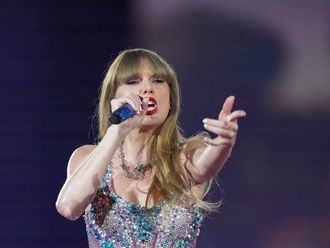Dubai: A crash on Indian stock markets and decline in the value of rupee continued unabated on Friday as the Reserve Bank of India’s (RBI) policy setting meeting did not change interest rates or gave any hint of market intervention to support the rupee.
The Indian rupee ended at fresh record low of 73.76 per dollar on Friday. Rupee touched a record intra-day low of 74.22 per dollar, but it recovered and ended up 18 paise against the greenback.
Asia’s worst performing currency crossed 74 mark just after RBI announcement where central bank kept the repo rate unchanged at 6.50 per cent but changed the stance from neutral to calibrated tightening.
The simultaneous fall in the currency and the stocks for the second consecutive day have fuelled speculation among market circles that the currency could plunge to $75 as early as next week and this could fuel further sell off on stock markets.
The Sensex slumped 966 points to an intra-day low of 34,202.22 points, while the Nifty tanked over 330 points to an intra-day low of 10,261.90 points. The benchmark BSE Sensex closed Friday’s trade 792.17 points or 2.25 per cent lower at 34,376.99 points. The NSE Nifty closed at 10,316.45 points, down 282.80 points or 2.67 per cent. All sectoral indices, barring the Nifty IT index, closed in the red.
Analysts said the RBI decision to keep interest rates unchanged at this critical juncture when the markets are panicking has come as a surprise.
“Contrary to most expectations, the RBI’s MPC chose to keep repo and reverse repo rates unchanged at its meet on October 05, 2018. It seemed to be influenced by risks to future growth from tighter financial conditions and encouraged by softer inflation projections. In the process the MPC chose to go contrary to the stance of most other Central Banks which may not be conducive for the value of Rupee,” said Deepak Jasani, Head Retails Research at HDFC Securities
The stock markets which would in normal case be happy with no hike, resumed its fall after a small bounce, as if the markets were waiting to sell-off post the event whatever be the outcome.
The rupee is down close to 14 per cent year to date. The fall has been attributed to global and domestic cues such as the monetary policy tightening in the US resulting in dollar strength and subsequent withdrawal of foreign portfolio investments. Additionally, the rising price of crude oil that accounts for more than 30 per cent of India’s imports and the absence of decisive intervention in the market has been driving down the currency.
Additionally, a weak trade position with a bulging current account deficit (CAD or the difference in the value of exports and imports) has made rupee’s position further precarious. CAD in the first quarter of this fiscal widened to $15.8 billion, which is around 2.4 per cent of the country’s Gross Domestic Product (GDP), as compared with $15 billion in the corresponding quarter a year before.
Analysts see further grim outlook for the rupee and Indian stocks. “Trend is likely to be negative at least in the near-term till the financial market stabilises. Key data like bond yield, INR, oil prices, liquidity and equity valuation has to normalise which may take some more time,” said Vinod Nair, Head Of Research, Geojit Financial Service.
DBS Bank forecast says that the currency will slide to as weak as 75 per dollar. Earlier in the year UBS Securities India had cut its year-end forecast to 73 from 66, while Scotiabank saw the rupee nearing 74 in the run up to the Federal Reserve meeting.
Meanwhile, Bank of America Merrill Lynch has widened its current account deficit (CAD) estimate by 0.20 per cent to 2.8 per cent of GDP for fiscal year 2018-19 citing high crude oil prices which the brokerage said can reach up to $95 by June 2019.











